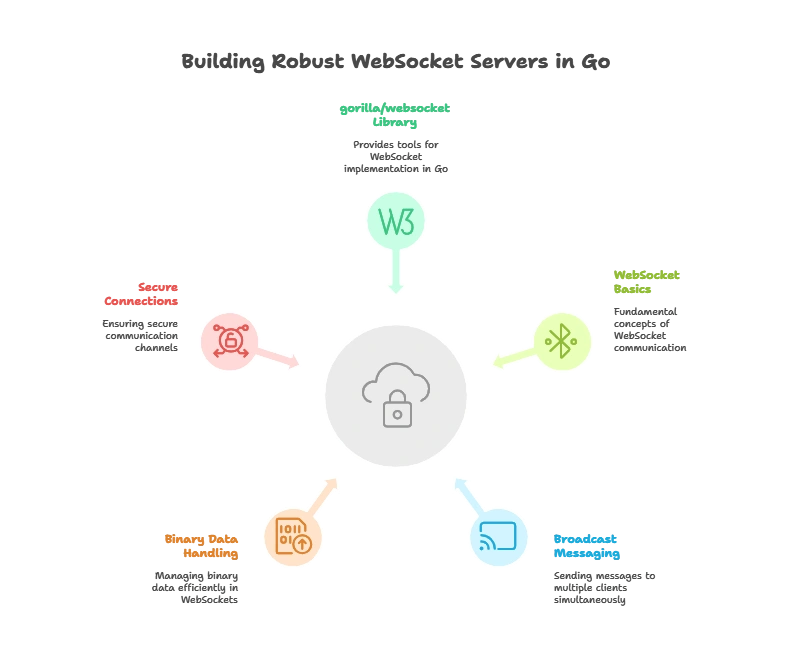WebSockets and Real-Time Communication in Go
In this chapter, we'll explore the concept of WebSockets and how they enable real-time communication between clients and servers in Go. We'll start with the basics and gradually delve into more advanced topics, covering everything you need to know about implementing WebSockets in Go.
Understanding WebSockets
WebSockets are a communication protocol that provides full-duplex communication channels over a single TCP connection. Unlike traditional HTTP requests, which are stateless and short-lived, WebSockets allow for persistent, bidirectional communication between clients and servers, making them ideal for real-time applications such as chat, gaming, and live updates.
Let’s dive into implementing a basic WebSocket server in Go.
Setting Up the Environment
Ensure you have Go installed on your system. We’ll use the gorilla/websocket library for WebSocket support.
go get github.com/gorilla/websocket
Implementing a WebSocket Server
package main
import (
"log"
"net/http"
"github.com/gorilla/websocket"
)
var upgrader = websocket.Upgrader{
ReadBufferSize: 1024,
WriteBufferSize: 1024,
}
func wsHandler(w http.ResponseWriter, r *http.Request) {
conn, err := upgrader.Upgrade(w, r, nil)
if err != nil {
log.Println("Upgrade error:", err)
return
}
defer conn.Close()
for {
messageType, p, err := conn.ReadMessage()
if err != nil {
log.Println("Read error:", err)
return
}
log.Printf("Received message: %s", p)
// Echo back the message
if err := conn.WriteMessage(messageType, p); err != nil {
log.Println("Write error:", err)
return
}
}
}
func main() {
http.HandleFunc("/ws", wsHandler)
log.Fatal(http.ListenAndServe(":8080", nil))
}
- We define an HTTP handler
wsHandlerto handle WebSocket connections. - When a WebSocket connection is established, we upgrade the HTTP connection to a WebSocket connection using
upgrader.Upgrade. - Inside the WebSocket connection loop, we read messages from the client using
conn.ReadMessageand echo them back usingconn.WriteMessage.
Advanced WebSockets in Go
Now that we’ve covered the basics of setting up a WebSocket server in Go, let’s delve into some advanced features and scenarios you may encounter when working with WebSockets.
Broadcast Messaging
In real-time applications, it’s often necessary to broadcast messages to multiple clients simultaneously. For example, in a chat application, when one user sends a message, it should be delivered to all other users in the chat room.
To implement broadcast messaging in Go with WebSockets, you can maintain a list of active WebSocket connections and iterate over them to send messages.
Here’s an example of how you can modify the wsHandler function to support broadcasting:
var clients = make(map[*websocket.Conn]bool) // Map to store active clients
func wsHandler(w http.ResponseWriter, r *http.Request) {
conn, err := upgrader.Upgrade(w, r, nil)
if err != nil {
log.Println("Upgrade error:", err)
return
}
defer conn.Close()
// Add client to the map of active clients
clients[conn] = true
for {
messageType, p, err := conn.ReadMessage()
if err != nil {
log.Println("Read error:", err)
delete(clients, conn) // Remove client from the map on error
return
}
log.Printf("Received message: %s", p)
// Broadcast message to all active clients
for client := range clients {
if err := client.WriteMessage(messageType, p); err != nil {
log.Println("Write error:", err)
client.Close() // Close client connection on error
delete(clients, client) // Remove client from the map on error
}
}
}
}
In this modified wsHandler function:
- We maintain a map
clientsto store all active WebSocket connections. - When a new client connects, we add it to the
clientsmap. - Inside the message handling loop, we iterate over all active clients in the
clientsmap and broadcast the received message to each client.
Handling Binary Data
WebSockets support both text and binary data. While the previous examples dealt with text messages, handling binary data is equally important, especially in applications involving file transfers, multimedia streaming, or binary protocols.
To handle binary data with WebSockets in Go, you can specify the message type as websocket.BinaryMessage when sending and receiving messages. The process is similar to handling text messages, but you’ll work with byte slices instead of strings.
Here’s an example of sending and receiving binary data with WebSockets in Go:
// Sending binary data
data := []byte("Hello, this is binary data")
err := conn.WriteMessage(websocket.BinaryMessage, data)
if err != nil {
log.Println("Write error:", err)
}
// Receiving binary data
messageType, data, err := conn.ReadMessage()
if err != nil {
log.Println("Read error:", err)
}
log.Printf("Received binary data: %v", data)
Securing WebSocket Connections
Securing WebSocket connections is essential to ensure the confidentiality and integrity of data transmitted between clients and servers. To achieve this, you can use TLS encryption by serving your WebSocket server over HTTPS.
To serve a WebSocket server over HTTPS, you’ll need to obtain an SSL/TLS certificate and configure the server to use it. You can use the http.ListenAndServeTLS function to serve the WebSocket server over HTTPS.
Here’s an example of serving a WebSocket server over HTTPS:
func main() {
http.HandleFunc("/ws", wsHandler)
// Load SSL/TLS certificate and key
certFile := "server.crt"
keyFile := "server.key"
// Start HTTPS server with SSL/TLS
log.Fatal(http.ListenAndServeTLS(":8080", certFile, keyFile, nil))
}
In this example, replace "server.crt" and "server.key" with the paths to your SSL/TLS certificate and key files.
By serving your WebSocket server over HTTPS, all data transmitted between clients and the server will be encrypted, providing a secure communication channel.

In conclusion, WebSockets provide a powerful mechanism for enabling real-time communication between clients and servers in Go. By leveraging the gorilla/websocket library and understanding the basics of WebSocket communication, developers can build scalable and interactive real-time applications. With advanced features like broadcast messaging, binary data handling, and secure connections, Go developers can create robust and secure WebSocket servers tailored to their application requirements. Happy coding !❤️
